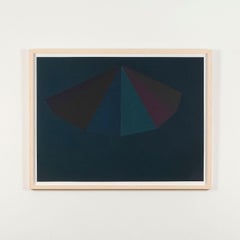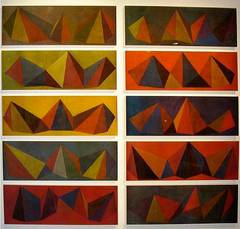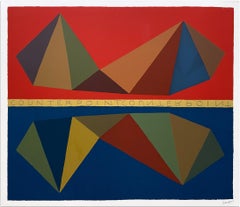Lewitt Pyramid
1980s Abstract Geometric Abstract Prints
Screen
1980s Minimalist Abstract Prints
Screen
Recent Sales
20th Century Minimalist Prints and Multiples
20th Century Contemporary Prints and Multiples
Other Medium
Vintage 1980s American Paintings
Late 20th Century Abstract Abstract Prints
Screen, Paper
People Also Browsed
2010s Ukrainian Stools
Steel
1970s Abstract Expressionist Mixed Media
Mixed Media
2010s American Mid-Century Modern Wall Lights and Sconces
Brass, Bronze, Enamel, Nickel
Antique 15th Century and Earlier African Natural Specimens
Bone
Mid-20th Century French Brutalist Chairs
Elm
2010s American Modern Night Stands
Iron
2010s Mexican Post-Modern Floor Lamps
Wicker
1990s Contemporary Abstract Prints
Etching, Aquatint
Vintage 1970s French Post-Modern Sofas
Leather
2010s American Chandeliers and Pendants
Steel
Vintage 1950s Austrian Mid-Century Modern Chandeliers and Pendants
Brass
Vintage 1940s Danish Scandinavian Modern Armchairs
Fabric, Upholstery, Wood, Beech
Vintage 1970s Italian Mid-Century Modern Table Lamps
Chrome
Vintage 1960s German Rococo Dinner Plates
Gold
Vintage 1960s Swedish Scandinavian Modern Chandeliers and Pendants
Brass
2010s Portuguese Chandeliers and Pendants
Brass
Sol LeWitt for sale on 1stDibs
While New York City’s art scene in the 1950s and ’60s revolved around Abstract Expressionism, multidisciplinary artist Sol LeWitt paved an alternative path, creating a prolific output of work in the genres of minimalism and, later, Conceptual art.
While LeWitt is perhaps best known for his immense “wall drawings,” he created work in a wide range of media, including drawing, painting, printmaking and sculpture. (However, in a characteristic rebuttal of canonical art history, he referred to these pieces as “structures.”) He also produced several texts, including the seminal Sentences on Conceptual Art (1969).
Born in Hartford, Connecticut, in 1928, LeWitt received a BFA from Syracuse University before going to work as a graphic designer for the renowned architect I.M. Pei. He would later work at the book counter at the Museum of Modern Art, where his colleagues included fellow artists. LeWitt’s early exposure to architecture may well have had outsize influence on his subsequent career: He was known for the geometric nature of his work, specifically his fastidious, near-obsessive treatment of the cube, which he rendered repeatedly in various ways throughout his paintings, structures and wall drawings.
In the 1960s, LeWitt showed in several group exhibitions throughout New York and also began to experiment with three-dimensional structures, most modular riffs on the cube shape. His work was included in “Working Drawings and Other Visible Things on Paper Not Necessarily Meant to Be Viewed as Art,” curated by Mel Bochner, another leading exponent of Conceptualism.
Later, LeWitt debuted his now-iconic wall drawings, creating work directly on the walls of galleries and show spaces, beginning with pioneering gallerist Paula Cooper’s inaugural show in 1968. The wall drawings became a prime example of LeWitt’s philosophical approach to art, with their installation often carried out by museum staff or curators following precise instructions from the artist.
“The idea,” the artist once said, “becomes a machine that makes the art.” LeWitt continued to produce work until his death in 2007.
Find a collection of original Sol LeWitt art on 1stDibs.
Finding the Right Prints-works-on-paper for You
Decorating with fine art prints — whether they’re figurative prints, abstract prints or another variety — has always been a practical way of bringing a space to life as well as bringing works by an artist you love into your home.
Pursued in the 1960s and ’70s, largely by Pop artists drawn to its associations with mass production, advertising, packaging and seriality, as well as those challenging the primacy of the Abstract Expressionist brushstroke, printmaking was embraced in the 1980s by painters and conceptual artists ranging from David Salle and Elizabeth Murray to Adrian Piper and Sherrie Levine.
Printmaking is the transfer of an image from one surface to another. An artist takes a material like stone, metal, wood or wax, carves, incises, draws or otherwise marks it with an image, inks or paints it and then transfers the image to a piece of paper or other material.
Fine art prints are frequently confused with their more commercial counterparts. After all, our closest connection to the printed image is through mass-produced newspapers, magazines and books, and many people don’t realize that even though prints are editions, they start with an original image created by an artist with the intent of reproducing it in a small batch. Fine art prints are created in strictly limited editions — 20 or 30 or maybe 50 — and are always based on an image created specifically to be made into an edition.
Many people think of revered Dutch artist Rembrandt as a painter but may not know that he was a printmaker as well. His prints have been preserved in time along with the work of other celebrated printmakers such as Pablo Picasso, Salvador Dalí and Andy Warhol. These fine art prints are still highly sought after by collectors.
“It’s another tool in the artist’s toolbox, just like painting or sculpture or anything else that an artist uses in the service of mark making or expressing him- or herself,” says International Fine Print Dealers Association (IFPDA) vice president Betsy Senior, of New York’s Betsy Senior Fine Art, Inc.
Because artist’s editions tend to be more affordable and available than his or her unique works, they’re more accessible and can be a great opportunity to bring a variety of colors, textures and shapes into a space.
For tight corners, select small fine art prints as opposed to the oversized bold piece you’ll hang as a focal point in the dining area. But be careful not to choose something that is too big for your space. And feel free to lean into it if need be — not every work needs picture-hanging hooks. Leaning a larger fine art print against the wall behind a bookcase can add a stylish installation-type dynamic to your living room. (Read more about how to arrange wall art here.)
Find fine art prints for sale on 1stDibs today.



